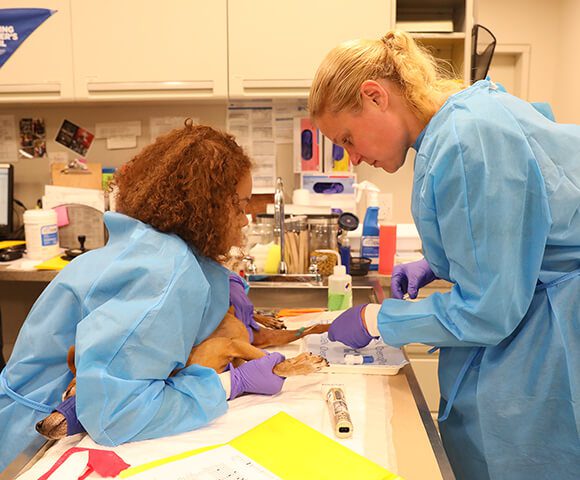Types of anticonvulsant medications for pets.
Phenobarbital.
Phenobarbital is perhaps the most widely used anticonvulsant. It is administered two times per day. A patient on phenobarbital must have blood levels monitored periodically for therapeutic levels and to ensure the drug does not reach toxic levels in the bloodstream. Metabolism of the drug tends to vary widely on an individual basis; therefore, two dogs of the same weight may require vastly different dosages.
In general, phenobarbital is considered a safe drug when levels and blood analysis (complete blood count and biochemistry) are performed regularly. Many owners report an increase in their pet’s appetite and thirst when initially placed on phenobarbital. Within the first three weeks of therapy, it is also normal to see mild to moderate sedation, which usually subsides after a few weeks. Liver disease and bone marrow suppression are sometimes seen.
Care should be taken with the diets of such patients to help avoid obesity.
Because phenobarbital is an addictive drug, it should never be decreased or withdrawn suddenly. Always consult with the doctor before adjusting medication dosages.
Potassium bromide (KBr).
Potassium bromide is another frequently used anticonvulsant medication. It is administered by itself or in conjunction with phenobarbital. This is a chemical-grade substance administered orally with food either once or twice daily. The liver does not metabolize bromide, and thus much of the chemical is passed in the urine and to a lesser degree in the saliva. Wearing rubber gloves is ideal while giving the drug or cleaning up any urine accidents or medication spills.
Potassium bromide is a safe drug with minimal side effects. The most common side effects include increased thirst and appetite and hind limb weakness. Sedation can also be seen initially or if the serum level is higher than therapeutic level. Vomiting and, rarely, dermatitis are reported.
Bromide levels must also be monitored periodically for therapeutic levels and possible dose adjustments. The frequency at which this is done is determined by the status of each patient; however, they must be checked at least once a year. The salt intake of your pet should remain consistent, as excess salt intake could affect the elimination of bromide.
Fluid therapy, furosemide, polydipsia (increased water consumption), steroid administration and changes in diet can all affect the blood level of bromide.
Zonisamide.
Zonisamide is a newer effective anticonvulsant medication. It is a safe drug that has few side effects. The drug is well tolerated and is given twice a day. The most common side effect is a transient sedation at the beginning of the treatment. Although metabolized by the liver, hepatotoxicity has not been reported and there is no increment of the liver enzymes. We do not usually see the increase in thirst and appetite as we do with phenobarbital and bromide.
The dose should be higher when zonisamide is used with phenobarbital. Over the years, the generic form has become more affordable, even for larger dogs.
It is the drug of choice when the side effects seen with the previous anticonvulsant drugs are of concern for the pets and the client.
Keppra® (levetiracetam).
Keppra is also a newer anticonvulsant drug with minimal side effects. Based on clinical experience, the transient sedation observed with this drug is more severe than with zonisamide.
The drug is given three times a day. We do not recommend regular serum level monitoring as the margin of safety for this drug is wide and the response to treatment does not correlate with the level of drug in the system.
Others.
Other anticonvulsant drugs are available for the control of seizures in dogs. These include the benzodiazepine family, gabapentin, valproic acid and felbamate. Because of resistance, side effects or increased frequency of administration, these drugs are not our primary choice for the treatment of seizures in dogs. In some circumstances, they can be used as an additional therapy in combination with other drugs.
Administration of medications.
Some important factors to remember when your pet is on anticonvulsant medication include:
- Compliance with directions. Proper dosages must be given at regular, on-time intervals. Missing or being late with just one dose may be enough to trigger a cycle of seizure activity.
- Make a chart, or log, of any and all seizure activity experienced by your pet. This includes any unusual events, time of day of seizure(s), length of seizure and current dosages of medication being given.
- Always give the phenobarbital or zonisamide 12 hours apart at the same time every day. Keep it as consistent as you can.
- Always give potassium bromide with food and at the same time every day. If you give KBr twice a day, give it 12 hours apart.
- Keppra is administered every eight hours (3x/day).
- Serum level is needed with most drugs with the exception of Keppra. The monitoring interval depends upon the half-life of the drug (how fast the drug is eliminated from the blood), the side effects seen and the control of the seizure.
Complete blood count, biochemistry and urinalysis are recommended with a maximum interval of 8 to 10 months.
Medications cannot be dispensed without periodic examinations and drug levels being performed.
For more information on this subject, speak to the veterinary neurologist or veterinarian who is treating your pet.


